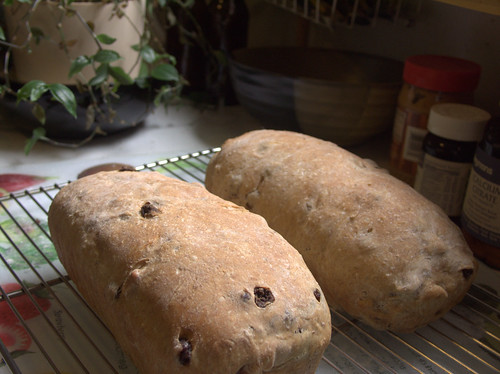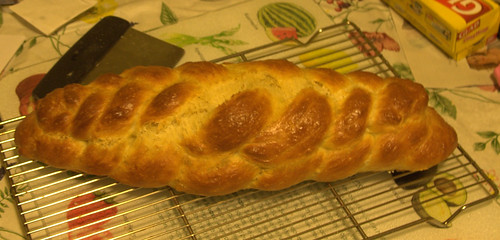The Challenge Bread
This week, we're making Ciabatta.


A Little History
I first remember having Ciabatta about eight years ago, when I ordered a sandwich and they asked me if I wanted it on Ciabatta...not knowing what it was I just agreed that is sounded good. It is now one of my favorite breads to eat (and now make!)
The Ingredients
I went with the Poolish version of this recipe, as I haven't really made anything with a poolish yet:
- Poolish
- Bread Flour
- Salt
- yeast
- Water
Corn/Dairy Free changes
Since this a Primary loaf, there isn't much to it, hence no corn or dairy. The taste and character comes from the baking.
The Shaping
The night before the baking, I made up the poolish and let it ferment in the fridge overnight. This allows the yeast more time to break down the flour into delicious gluten. The next day, I combined the ingredients with the poolish. The dough is very wet and can be hard to work with. The wetter, the harder, but the bigger the air pocket are.
Once I was done kneading the dough, I transferred it to the Generously floured counter. I shaped the dough into a rough rectangle. I then sprinkled another generous portion of flour on top of the loaf. Then, grabbing opposite ends of the dough, I picked it up, and let it stretch to about twice the original size. I placed it back down on the counter, and folded it up like a letter. I lightly misted it with oil, covered it in plastic, and let it rest for 30 minutes. I then did another stretching session.
After the stretching, I took a heavy Towel and setup a couche: a floured towel used to create crusty breads. I let the loaves proof until they had "noticeably swelled."
The Baking
I preheated the oven to 500 degrees. I put a cookie sheet on the topmost oven rack, while moving the other rack to the lowest setting. Once the oven was up to temp, I put a cup of hot water into the steam pan, and put the loaves on the lowest rack. After 30 seconds, I opened the oven, and sprayed the sides with water to generate more steam. I did this twice more at 30 second intervals, and then turned the oven down to 450 degrees. I baked the loaves for 10 minutes, and then rotated them 180 degrees and continued to bake them until they reached an internal temperature of 205. I then placed them on a cooling rack for about an hour.
Results and My Final Thoughts/Notes
The end result was good. The crust was fairly crusty, but not too hard. I didn't get as big of air pockets as I wanted, but they were pretty good.
Again, I think one of the main things I learned this week would be timing. I think I let the dough sit more than 30 minutes, as it kind of swelled out and almost off the pan! Then, I think I over compensated and didn't let the loaves proof long enough on the couche.
As the saying goes, there's no bad homemade bread....unless it burnt.
Up Next…
Next week, we're making Cinnamon Rolls!
Comments? Suggestions?
So what do you think? Sound good? Anything I should change/do better?
 [/caption]
[/caption]


